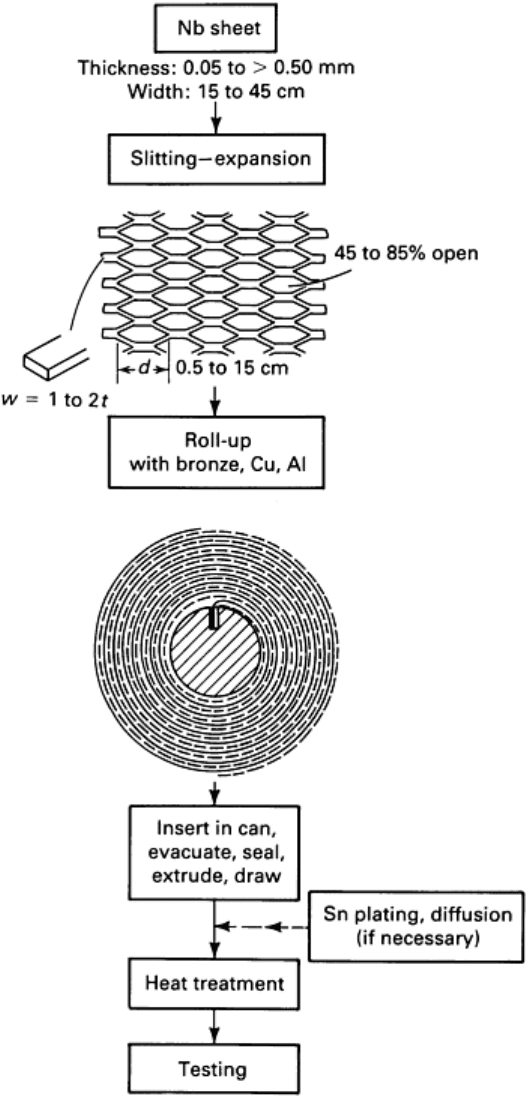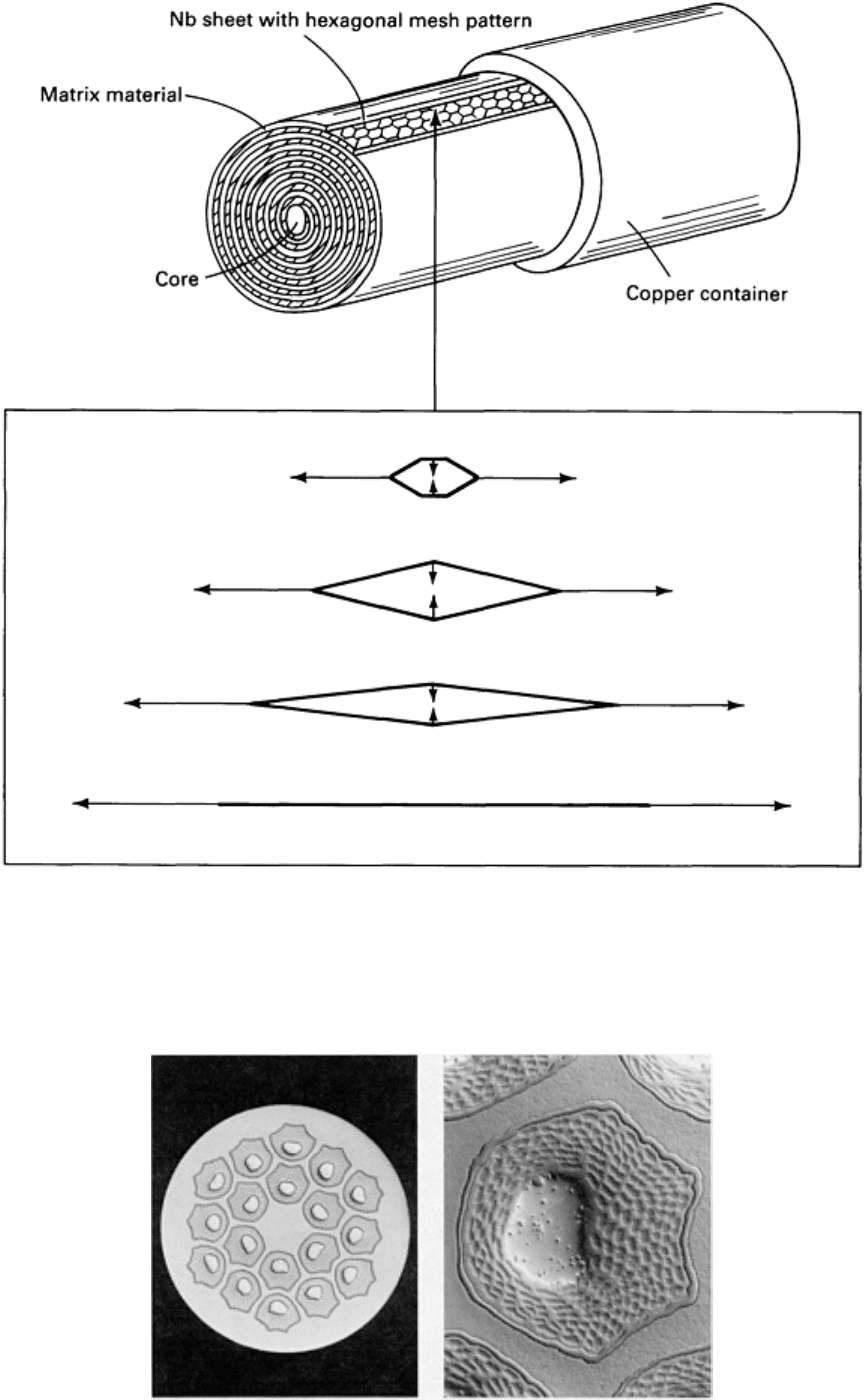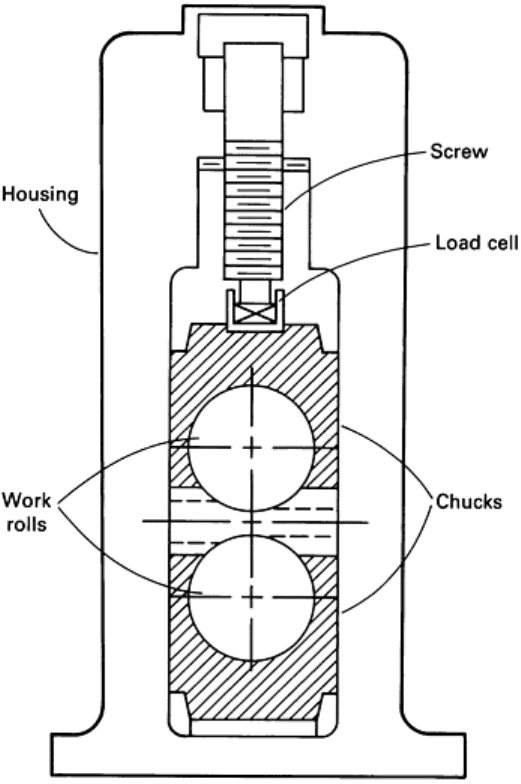ASM Metals HandBook Vol. 14 - Forming and Forging
Подождите немного. Документ загружается.


With high-strength materials such as steels, stainless steels, and high-temperature alloys, the surface of the rod or wire can
be coated either with a softer metal or with a conversion coating. Copper or tin can be chemically deposited on the surface
of the metal. This thin layer of softer metal acts as a solid lubricant during drawing. Conversion coatings may consist of
sulfate or oxalate coatings on the rod; these are then typically coated with soap, as a lubricant. Polymers are also used as
solid lubricants, such as in the drawing of titanium.
In the case of steels, the rod to be drawn is first surface treated by pickling. This removes the surface scale that could lead
to surface defects and therefore increases die life.
In wet drawing, the lubricant is chosen both for its tribological attributes and for its cooling power, and it can be either
oil-base or aqueous. It can be applied to the die inlet, the wire, and often also to the capstan, or the entire machine can be
submerged in a bath. When the machine operates with slip, the lubricant must reduce wear of the capstan while
maintaining some minimum friction. This wet-drawing practice is typical of all nonferrous metals and of steel wires less
than 0.5 to 1 mm (0.02 to 0.04 in.) in diameter.
A transition between the two techniques is sometimes used, particularly in the low-speed drawing of bar and tube. A high-
viscosity liquid or semisolid is applied to the workpiece and/or die. Reference 8 provides additional details on the
lubrication of ferrous wire.
References cited in this section
7.
S. Kalpakjian, Manufacturing Processes for Engineering Materials, Addison-Wesley, 1984
8.
A.B. Dove, Ed., Steel Wire Handbook, Vol 4, The Wire Association International, Inc., 1980
Wire, Rod, and Tube Drawing
The Manufacture of Commercial Superconductors
*
The design requirements of commercial superconductors have challenged metal extrusion and composite metal-drawing
technology such that superconductors with 10,000 to 40,000 filaments, several microns in diameter, are available in wire
form. On an experimental basis, wires have been produced with 1 million filaments less than 1 m (40 in.) in diameter.
Understanding the reasons for this challenge to metal-forming technology requires a brief introduction to engineering
requirements for commercial superconductors.
The design and application of superconductors is mainly controlled by the critical temperature, T
c
. Niobium-base
superconductors are usually used at liquid helium temperatures (4.2 K). At these temperatures, specific heats of materials
are typically in the 10
-3
J range. Small mechanical or electromagnetic disturbances can provide sufficient heat to raise the
temperature of the superconductor above T
c
; this increase in temperature causes the normally high resistance to return.
Commercial superconductors are designed to prevent and/or control the change to the nonsuperconducting state.
Copper and aluminum are usually used as the matrix; copper is the preferred matrix because of its mechanical
compatibility with the niobium-base superconductors. If an event occurs that is sufficient to return the superconductor to
the normal state, the copper temporarily conducts the current until the superconductor is cooled below the critical
temperature.
The sizes of the filaments of the superconductor are chosen to be in the 100 μm (4000 μin.) range--small enough to
prevent an electromagnetic instability called a flux jump. For applications requiring precise magnetic fields, as in dipole
magnets, filaments must be in the 1 μm (40 μin.) range. Power frequency applications require filaments of less than 1 μm
(40 μin.).
Commercial superconductors for power applications are manufactured by a coextrusion and composite-drawing process.
The resulting wire consists of one to tens of thousands of filaments of the superconductor, each individually surrounded
by a normal metal matrix. The superconductor itself is usually a ductile alloy of niobium and titanium (Fig. 14) or a brittle
intermetallic of niobium and tin (Nb
3
Sn) (Fig. 15 and 16).

Fig. 14 Cross section of 500 niobium-titanium filaments separated by a copper substrate and enclosed within a
copper-nickel tube. Courtesy of Oxford Superconducting Technology.
Fig. 15 Cross section of niobium filaments reacted with tin in the bronze substrate to form Nb
3
Sn.
Courtesy of
Oxford Superconducting Technology.

Fig. 16 Cross section of 3000 filaments of Nb
3
Sn in final conductor.
Courtesy of Oxford Superconducting
Technology.
Superconducting multifilamentary conductors are manufactured using a combination of extrusion and wire-drawing
techniques (up to 40 to 50 such separate sequences may be necessary) to make up to 1 million individual wire filaments of
microscopic size enclosed within a wire having outside diameter of fractions of an inch. The two primary techniques used
are billet stacking and the modified jelly-roll method.
Billet Stacking Method. The manufacture of a typical niobium-titanium superconductor with filaments in the 10 to
100 μm (400 to 4000 μin.) range begins with the assembly of a billet (Fig. 17). The billet is assembled by inserting rods of
the superconductor into an array of tubes of CDA 101 copper with a hexagonal outer shape and a round inner diameter.
The array approximates a circle having a diameter slightly less than the copper extrusion can placed over it. A typical
billet is 305 mm (12 in.) in diameter and 762 mm 30 in. long.

Fig. 17 Fabrication steps and process parameters required to manufacture multicore niobium-
titanium filament
conductors. Courtesy of Intermagnetics General Corporation.
The billet is evacuated to remove the air and electron beam welded to form a vacuum-tight seal. The elements in the billet
are metallurgically bonded and uniformly reduced in area by a hot direct extrusion. Reduction ratios of 16 to 1 are
generally used, requiring extrusion forces typically in the 31 to 44 MN (3500 to 5000 tonf) range. The resulting extrudate
is normally 10 m (33 ft) long by 85 mm (3.3 in.) in diameter. This rod is then cold drawn using a proprietary die and
reduction schedules designed to ensure uniform coreduction of the superconducting filaments. The initial draw process
requires benches as long as 60 m (200 ft), with 590 kN (60,000 kgf) of draw force to be used to ensure that the rod does
not have to be cut before it is coiled for further drawing. The remaining process involves performing heat treatment and
draw cycles to develop the current capacity of the superconductor, annealing the matrix, and uniformly coreducing the
filaments. Specially modified wire-drawing machinery is generally used. The final step is an anneal to restore the ductility
and resistivity of the copper matrix. Preceding this step is a twisting operation, which twists the wire upon itself. This
twists the filaments inside the composite, ensuring that the filaments act individually under electromagnetic fields.
Superconductors requiring more than 5000 or 6000 filaments or, correspondingly, filaments of sizes less than 10 m (400
in.) are made by coextruding a single filament, which, in the case of niobium-titanium, usually has a diffusion barrier.
This ensures that no damaging intermetallics form during the extrusion or heat treatment process. This extrudate is drawn
to the appropriate size and assembled into a second extrusion billet; the process is then repeated.
The extrusion and draw process can be repeated a number of times to produce wires with 20,000 to 1 million or more
filaments. As shown in Fig. 18, a first-generation billet can yield 19 individual filaments in the wire configuration. Sixty
one of these 19-filament wires were then stacked, extruded, and drawn to yield a 19 × 61 array of 1159 filaments in the
second-generation billet. The third-generation billet, consisting of 61 of the 1159 filament wires obtained in the second-
generation billet, was stacked, extruded, and drawn to yield a 70,699 filament superconducting wire. However, the
problem of "sausaging," or filament nonuniformity, especially in the outer diameter of the conductor, becomes more
evident as more extrusions and drawings of the wire are attempted.

Fig. 18 Cross section of billet assembly used to produce a 70 699-filament wire using up to third-
generation
billets. (a) First-generation billet. (b) Second- and third-generation billets.
For these developmental conductors, the matrix is often composed of several metals or alloys of metals, such as copper
nickel, or is alloyed slightly with magnetic impurities, such as manganese. This ensures that the electromagnetic and
physical sizes of the micron-size filaments are the same.
The manufacture of Nb
3
Sn in filamentary form has presented some unusual problems because of the brittle nature of the
superconductor. The accepted processes are based on forming the brittle phase at the final stage. Early technology carried
the tin in a 13 wt% bronze matrix. The manufacturing process was a multiple coextrusion and codrawing process similar
to that for niobium-titanium. The work-hardening rates of bronze require many anneals, and this can lead to premature
formation of the brittle phase. More recently, a process based on maintaining the tin in its pure phase has gained
acceptance. This is called the internal tin process.
The standard process begins with a billet of copper and niobium filaments assembled into a tubular array (Fig. 19). The
billet follows the usual procedures for niobium-titanium, but is extruded with a mandrel to maintain the hole. The
resulting extrudate typically has several hundred filaments of niobium in a copper matrix with a hole of about 10% of the
diameter running throughout the length at the center. Tin is inserted into the hole, and the resulting composite is drawn to
a size suitable for assembly into the stabilizer tube. This tube is also formed from a hollow extrusion but is composed of
copper and a diffusion barrier such as niobium or vanadium. The diffusion barrier keeps the tin from alloying with the
copper in the stabilizer. Quantities of 19 to 37 composite elements are assembled and inserted into the stabilizer tube. The
resulting rod is repeatedly drawn without any annealing to yield a wire having a diameter ranging from 1 mm to fractions
of a millimeter. The resulting conductor frequently has several to tens of thousands of filaments in the several micron size
range with multiple cores of tin. The wire is then heat treated to diffuse and then react the tin with the niobium to form the
Nb
3
Sn.

Fig. 19 Sequence of manufacturing operations involved in the formation of Nb
3
Sn multifilamentary wire using
the internal tin process. Courtesy of Intermagnetics General Corporation.
Modified Jelly-Roll Method. Instead of using rods, the modified jelly-roll method (Ref 9) utilizes thin (0.05 to 0.50
mm, or 0.0020 to 0.020 in., thick) niobium foil sheets that are slit with a number of discontinuous and staggered parallel
slits having controlled interconnection distances, d, of 5 to 150 mm (0.197 to 5.9 in.), as shown in Fig. 20. This niobium
sheet is subsequently stretched at right angles to the original slits to produce a diamond-shaped array of continuously
connected filaments--a hexagonal matrix that is 45 to 85% open. The expanded niobium sheet is then rolled up with the
designated matrix material (bronze, copper, and aluminum), inserted into a copper container, sealed, extruded, and
processed as conventional wire. As area reduction of the cross section progresses, the horizontal dimension d is stretched
and elongated, and the vertical dimension w is compressed by a factor of 100,000 to 1,000,000 to form the individual
filaments (Fig. 21(a) and 21(b)).

Fig. 20 Schematic of the modified jelly-roll process for producing superconducting multi-filamentary wire.

Fig. 21(a)
Detail of niobium sheet mesh rolled into a jelly roll using a matrix material to show how the
hexagonal mesh is transformed into an individual filament through elongation in the horizontal direction a
nd
compression in the vertical direction when subjected to extrusion and drawing.
Fig. 21(b) Cross section of a 0.78-mm (0.0307-in.) diam unreacted niobium-
tin multifilamentary composite

wire consisting of 18 subelements that were produced using the modified jelly-
roll method. The wire was cold
worked to a 160,000 to 1 reduction in area. Left: 65×. Right: Close-up of one of the
18 subelements showing
the individual niobium filaments surrounding a tin/copper alloy core and a vanadium barrier. 465× (differential
interference contrast). Courtesy of P. E. Danielson, Teledyne Wah Chang Albany.
Numerous billets 75 mm (3 in.) in diameter have been produced with a final niobium filament size of 1 to 2 m (40 to 80
in.) in diameter. It should be possible to achieve submicron filaments. At the commercial level, the process can be used
for Va
3
Ga, Nb
3
Al, Nb
3
Sn, NbTi, and other composites.
Reference cited in this section
9.
S. Foner and B.B. Swartz, Ed.,
Superconductor Materials Science: Metallurgy, Fabrication, and
Applications, Plenum Press, 1981
Note cited in this section
* This section was written by B.A. Zeitlin, Intermagnetics General Corporation
Wire, Rod, and Tube Drawing
References
1. G.E. Dieter, Mechanical Metallurgy, 2nd ed., McGraw-Hill, 1976, p 658
2. K. Lange, Ed., Massiveforming, in Textbook of Forming Technology, Vol II, Springer-
Verlag, 1974, p 227
(in German)
3. "Rathbone Cold-Drawn Profile Shapes and Pinion Rods," Technical Brochure, Rathbone Corporation
4. M.B. Bever, Ed., Encyclopedia of Material Sciences and Engineering,
Vol 2, Pergamon Press and The MIT
Press, 1986
5. W. Wick, Ed., Forming, Vol II, 4th ed., Tool and Manufacturing Engineers Handbook,
Society of
Manufacturing Engineers, 1984
6. Designer's Handbook: Steel Wire, American Iron and Steel Institute, 1974
7. S. Kalpakjian, Manufacturing Processes for Engineering Materials, Addison-Wesley, 1984
8. A.B. Dove, Ed., Steel Wire Handbook, Vol 4, The Wire Association International, Inc., 1980
9. S. Foner and B.B. Swartz, Ed.,
Superconductor Materials Science: Metallurgy, Fabrication, and
Applications, Plenum Press, 1981
Flat, Bar, and Shape Rolling
G. D. Lahoti, The Timken Company; S.L. Semiatin, Battelle Columbus Division
Introduction
ROLLING OF METALS is perhaps the most important metalworking process. More than 90% of all the steel, aluminum,
and copper produced--in 1985, some 800 million tons of material worldwide--go through the rolling process at least one
time. Thus, rolled products represent a significant portion of the manufacturing economy and can be found in many
sectors. Beams and columns used in buildings are rolled from steel. Railroad tracks and cars are made from rolled steel,
and airplane bodies are made from rolled aluminum and titanium alloys. The wire used in fences, elevator ropes, electrical
conductors, and cables are drawn from rolled rods. Many consumer items, including automobiles, home appliances,
kitchen utensils, and beverage cans, use rolled sheet materials.

In rolling, a squeezing type of deformation is accomplished by using two work rolls (Fig. 1) rotating in opposite
directions. The principal advantage of rolling lies in its ability to produce desired shapes from relatively large pieces of
metals at very high speeds in a somewhat continuous manner. Because other methods of metalworking, such as forging,
are relatively slow, most ingots and large blooms are rolled into billets, bars, structural shapes, rods (for drawing into
wire), and rounds for making seamless tubing. Steel slabs are rolled into plate and sheet.
Fig. 1 Typical rolling mill stand
Although the rolling of metals has been done for some time and has been a very productive means of working large
quantities of metals to a variety of shapes and sizes, the state of the technology had been somewhat stagnant until
recently, when major innovations started to appear. With the advent of computer-assisted controls, highly automated, very
high-speed rolling mills were installed beginning in the 1970s. One rod mill commissioned in 1980, for example, is
reported to roll steel wire rod at the rate of 335 kph (210 mph). This mill has a rated output of 545,000 Mg (600,000 tons)
per year, and the entire mill is operated from three climate-controlled pulpits equipped with computerized controls and
closed-circuit video monitors. Another modern mill came on stream in the early 1980s. It is a 200 cm (80 in.) hot strip
mill capable of producing steel coils up to 188 cm (74 in.) wide and weighing up to 33.6 Mg (37 tons). The mill features
computer controls that automatically adjust water flow rates, roll speeds, and strip temperatures to meet metallurgical
requirements. In addition to these developments, computer-aided modeling of the rolling process is now routinely used at
several locations for design of rolls and optimization of the process parameters (see the section "Mechanics of Plate
Rolling" in this article). Understanding of the materials also has improved considerably, thereby permitting development
of new products such as high-strength low-alloy (HSLA) steels, which require controlled rolling. In short, significant
developments are happening in this field, which was largely neglected for decades.
Acknowledgements
